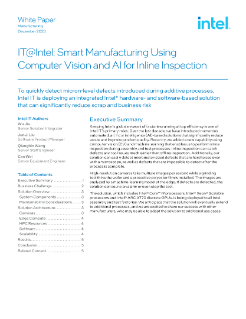Computer Vision and AI for Inline Inspection
To detect micron-level defects and reduce scrap, Intel IT is deploying an Intel® hardware- and software-based solution.
Intel IT is using computer vision and AI for inline inspection in Intel’s assembly and test factories.
Keeping Intel’s global network of factories running at top efficiency is one of Intel IT’s primary roles. Over the last decade, we have introduced numerous automated, artificial intelligence (AI)-based solutions that significantly reduce waste and improve product quality. Recently, we added a new capability using computer vision (CV) and machine learning that enables us to perform inline inspection during assembly and test processes. Inline inspection can catch defects and tool issues much earlier than offline inspection. Additionally, our solution, called Intelligent Wafer Vision Inspection (IWVI), can easily detect micrometer-sized defects that are hard to see even with a microscope, as well as defects that are impossible to detect after the process is complete.
High-resolution cameras take multiple images per second while a grinding tool thins the wafer, and a protective polyester film is installed. The images are analyzed by a machine-learning model at the edge. If defects are detected, the solution can sound an alarm or even stop the tool.
The solution, which includes Intel® Core™ i9 processors, Intel® Xeon® Scalable processors and Intel® ARC A770 discrete GPUs, is being deployed to all Intel assembly and test factories.
The IWVI solution has been identified as a critical solution to help ensure the quality and reliability of new generations of products in Intel’s factories of the future. Its standardized design results in fast deployment and easy extendibility to new use cases. The PoC demonstrated that the solution could accurately identify many types of defects in the wafer-thinning process, including indentations, scratches of various sizes, grinding marks, stains, cracks, bubbles, wafer shift and mount shift.
The PoC demonstrated that up to 50% of wafer-thinning issues can be detected earlier with inline inspection compared to offline inspection. When the IWVI alarm sounds, the wafer can be reworked, which avoids whole-wafer delamination during downstream processes. More importantly, the solution goes beyond what was possible with offline metrology:
• Detects excursions as they occur.
• Detects process defects and shuts down the tool quickly.
• Enables a new capability to inspect frame cleanness and inner ring.
Using the IWVI solution, we achieve several business benefits:
• Scrap avoidance, saving Intel up to USD 2 million each year.
• Reduced business risk.
• Higher product quality.
• Freeing engineers from tedious manual offline inspection.
We anticipate that the solution will eventually extend to additional processes, and we are excited to share our success with other manufacturers, who may be able to adapt the solution to additional use cases.
